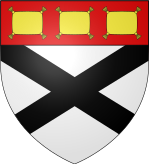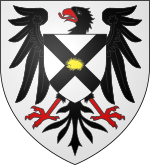Battle of Dryfe Sands facts for kids
Quick facts for kids Battle of Dryfe Sands |
|||||||
|---|---|---|---|---|---|---|---|
| Part of Johnstone-Maxwell feud | |||||||
  Coats of arms of the chief of Clan Johnstone (left) and chief of Clan Maxwell (right) |
|||||||
|
|||||||
| Belligerents | |||||||
| Clan Johnstone Clan Scott Clan Graham |
Clan Maxwell Clan Grierson Clan Pollock |
||||||
| Commanders and leaders | |||||||
| Sir James Johnstone | Lord John Maxwell † | ||||||
| Strength | |||||||
| 600-800 | 2,000 | ||||||
| Casualties and losses | |||||||
| "heavy" (only 160 survivors) |
700 killed | ||||||
The Battle of Dryfe Sands was an important fight between Scottish clans. It happened on December 6, 1593, near Lockerbie, Scotland. This battle was part of a long-running disagreement between the Clan Maxwell and Clan Johnstone that had lasted for about 100 years. In the end, the Johnstones won a clear victory over the Maxwells.
Contents
Why Did the Battle Happen?
Early Troubles Between Clans
In 1585, John Maxwell, 8th Lord Maxwell, got into trouble with the King. He had argued with the Earl of Arran, who was a favorite of James VI of Scotland. Because of this, the King gave a special job to Johnstone, Lord of Annandale. Johnstone became the "Warden of the West Marches," a powerful leader in the border region.
Maxwell had many supporters, so Johnstone needed help. Two groups of hired soldiers were sent to support him. But these soldiers were attacked by Maxwell's men and badly defeated. Robert Maxwell, the chief's brother, then burned Johnstone's home, Lochwood Castle. Later, Johnstone himself was defeated and captured. He was very upset by this loss.
Peace and New Problems
Soon after, Maxwell got back into the King's good graces. He even became the new Warden of the West Marches. Maxwell and Lord James Johnstone, the son of the defeated Lord Johnstone, made a peace agreement. For a while, the two clans lived without fighting.
However, the feud started again in 1593. A relative of Lord Johnstone, Johnstone of Wamphray, took a horse from someone in Nithsdale. He was caught and hanged. A nephew, William Johnstone, escaped and gathered a large group of Johnstones. They went to Nithsdale and took many cattle.
More Fights and Alliances
The people of Nithsdale asked Lord Maxwell for help. Maxwell agreed to protect them, and many powerful families in the area became his followers. This included families like Kirkpatrick of Closeburn and Douglas of Drumlanrig.
When Johnstone found out about this, the fighting between the clans started again. Buccleuch, the chief of the Scotts and a relative of Johnstone, came to help. His clan included the Clan Scott, Clan Eliott, Clan Armstrong, and Clan Graham.
With these new allies, Johnstone surprised a group of Maxwells near Lochmaben. They defeated them, and Robert Maxwell, who had burned Lochwood Castle, was killed. The Maxwells tried to hide in Lochmaben Church, but the Johnstones set fire to the church, and many inside lost their lives.
How the Battle Unfolded

Lord Maxwell was very angry about this. He marched into Annandale with 2,000 men. These included leaders from Nithsdale and even some royal soldiers. He reportedly offered a reward for Johnstone's head or hand.
The Scotts were a strong and brave clan. Since Dame Margaret Johnstone was Buccleuch's daughter, 300 Scotts joined Johnstone of Lochwood. Their leader was the Laird of Elibank. Two of Johnstone's local supporters, Johnstone of Kirktoun and Johnstone of Lockerbie, also joined with their men. The Grahams from the Debatable Lands also came, as they were always ready to fight the Maxwells.
Johnstone chose a good spot on high ground where the Dryfe river meets the Annan. As Maxwell's army came closer, a small group of Johnstones went forward. They teased the Maxwells, tempting them to charge uphill. Then, the Johnstones, Scotts, and Grahams rushed down from the high ground. A fierce fight began, and Johnstone won the battle. Lord Maxwell fought bravely but was killed. Many of his followers also died. Some leaders like Lag, Closeburn, and Drumlanrig escaped because they had fast horses.
About 700 Maxwells were killed in the battle. John Pollock, the son of the Clan Pollock chief, also died fighting for the Maxwells. Some who escaped were said to have "Lockerbie licks" on their faces. These were cuts from the swords of horsemen chasing them. Johnstone's side also had many losses. In 1594, he received a special pardon from the King for himself and only 160 surviving followers. Bell of Albie, a Johnstone supporter, was killed while chasing the Maxwells. A thorn bush, called "the Albie Thorn," was planted where he fell.
What Happened After the Battle?
Lord Maxwell's cousin, William Maxwell, became the next Warden of the West Marches. He tried to capture Johnstone's followers, causing more trouble in the area. Because of this, the King replaced him with Johnstone himself as Warden.
Douglas of Drumlanrig could not forget his defeat at Dryfe Sands. On July 13, 1597, he attacked Johnstone but failed to capture some rebels. As a result, Johnstone lost his Warden job, but it was given to his friend, Sir John Carmichael.
In 1608, Sir James Johnstone, now the Warden, met with John Maxwell, 9th Lord Maxwell. This was the son of the Maxwell who died in the battle. They met to try and end the feud peacefully. However, Maxwell shot Johnstone and then ran away to Europe. When he returned, he was put to death in Edinburgh in 1613 for serious crimes against the king and for killing the Warden.
Between 1591 and 1594, there were other troubles in Scotland. The death of Lord Maxwell, who was a strong Catholic, at the Battle of Dryfe Sands in 1593, and the defeat of other northern leaders in 1594, helped to end a Catholic uprising in Scotland.

